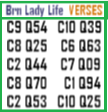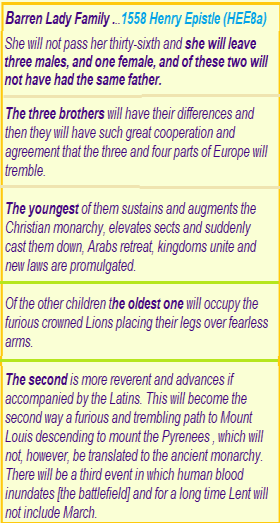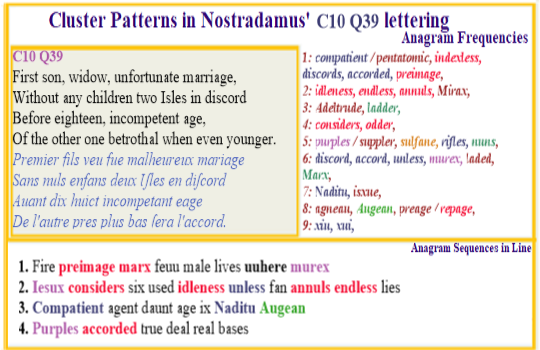 Analyses of all verses
Analyses of all verses
|
 Web Site
Web Site |
 All
Sefirots All
Sefirots |
Nostradamus C10 Q39: Rows over dyes and indolence make two countries ripe for war
Copyright: Allan Webber, December 2015

 The
text of this verse seems closely tied to the story of the Barren Lady
as seen alongside in the quote from the 1558 Epistle to Henry.
The
text of this verse seems closely tied to the story of the Barren Lady
as seen alongside in the quote from the 1558 Epistle to Henry.
It starts with First son, widow, unfortunate marriage, without any children and ends with Before eighteen, incompetent age, for the other one the betrothal will take place even younger which like the quote gives a specific age for the lady involved. Yet, although the style is that of the quote, there is no direct reference to a Barren Lady.
However this text makes sense if it relates to a woman who has had two marriages by the age of eighteen and a son born to a ill-suited husband all of whom die before that age.
In this context the verse provides further detail to the background story of the lady being considered barren being able to have four children who survive.
A technical peculiarity occurs in many of the verses covering the story of the Barren Lady's family and that relates to the very low frequency of rare anagrams contained in the lettering.
One explanation for this is that these verses rely on the detail in the text, rather than the anagrams. And that would be applicable if the setting relates to the mundane part of a futuristic biography. That certainly fits with the nature of the story that surrounds this family.
They are part of the future and shape it but not by doing anything that people in the sixteenth century couldn't. They might lead royal lives, have children, see them die, be motivated to go to war, fight battles but there is nothing in that life style to either frighten a populace or provide a base for a charge of heresy.
 In
this verse those anagrams that add most to Nostradamus' story of
this family, involve two words with which he was familiar.
In
this verse those anagrams that add most to Nostradamus' story of
this family, involve two words with which he was familiar.
But by their nature they act as code for regions in which the family in the verse and quote was prominent.
Those two anagrams are Murex (reux m) and purples (pres plus). Murex is a sea creature found near Tyre, from which highly expensive ancient purple dye was harvested for those royal or rich enough to afford it.
Other anagrams seem to define a purpose. In the first line there are 'uuhere' and 'lives'. And an anagram for purples occurs in the last line where the sequence of lettering creates true purples bases.
I can easily accept that Nostradamus had influence on these cryptic hidden messages since they reflect a little known aspect of his life.
In Nostradamus' life time the region between Agen and Alet les Bain flourished by producing pastel blue dye. It was the product not of a sea creature but a plant and it was a new industry that began around the time of Nostradamus' birth. For a short time until the plant degraded the soil this new cheaper source of colour ate into the lucrative murex trade.
Nostradamus' interest in that product and that region arises from his having lived nearby in Agen and Alet les Bains in the 1520s and 1530s.
In addition his interest in this topic would have been plausble because the history of the 16thC Royal French lineage was entwined with this pastel trade. Jean de Bernuy of Toulouse, the kingpin in the pastel industry was linked to the family that parented the Bourbon line. Bernuy was the major financer of the ransom needed to release Francis I from Spanish captivity. Although Francis was an ungrateful recipient of Bernuy's monies it was via Marguerite d'Angouleme, Francis sister, that de Bernuy became involved.
So by their presence in this verse it is quite possible the anagrams about the blue dye industry are meant to be cryptic but true clues as to regions in the Middle East and France where two of the Barren Lady's family became established. It implies one of them is in Southern France in or near the Pyrenees and the other is on the north eastern coast of the Mediterranean Sea.